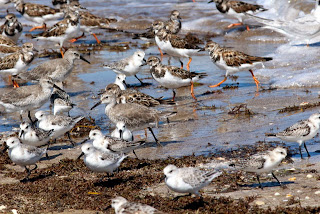Late Tuesday afternoon a researcher from Mexico identified a Crescent-chested Warbler on the Pinnacles Trail at Big Bend National Park. There is only one previous unphotographed report of this species for the state. I had the good fortune to find the third ABA record back in 1992 in Patagonia Arizona which is my second best all time find. Well I didn't get word about it till 1:30 PM on Wed. and I was on the road an hour later. Spent the night in Sanderson (only $25.95!) and was at the trail head by 8:40 Thursday morning. The bird had been sighted near the shady area with a few maple trees below the Pinnacles and Matt and Heidi from Marathon were already there when I arrived. Well, we couldn't find the bird, but is was still a very nice day on the mountain. Best bird for me was this Lucifer Hummingbird which I think may be a young male..


A couple of Hutton's Vireos came in close while I was pishing. They superficially look like a Ruby-crowned Kinglet but are a little chunkier with a heavier bill.
The Crescent-chested Warbler had been seen in association with a few Townsend's Warblers. But the few Townsend'ses I saw were not accompanied by their southern cousin. This one was wrestling a big caterpillar.
I saw several Empidonax flycatchers. Based on bill size and primary extension, this is a Hammond's Flycatcher.
It was so nice to get out of the heat and humidity of the Valley and enjoy some fall weather. The few maples were really putting on a show.
There's a little grove of aspen which are the southernmost in the USA. They were just starting to change.
I was really expecting some interesting butterflies as the summer monsoon has been pretty good this year, producing lots of wildflowers. But other than lots of beautiful California Sisters, there wasn't too much around.
This big hairy tarantula crossed my path on the way down.
On the hike up I was lucky to see this Texas Alligator Lizard but I was unable to get a decent photo.
After the good eight mile hike, I decided I was done with Big Bend for this time and headed up to spend the night in Alpine. The next morning I checked out Lake Balmorhea where I found a couple of Common Terns which are very uncommon in west Texas. Unfortunately they were too far for a photo so here's one of a Western Grebe.
I have not heard of anyone else making the trip to look for the Crescent-chested Warbler. I bet it's still up there. Should I try again?





















































